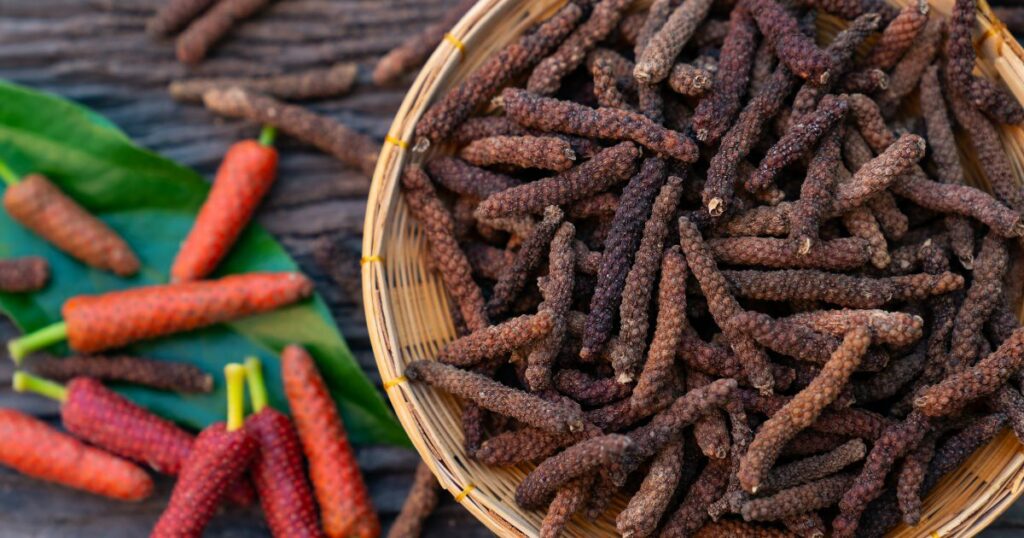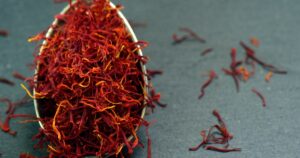The Historical Voyage of Long Pepper
Early Beginnings and Global Journey
The saga of long pepper begins in the ancient lands of India, where it was not only a prized culinary ingredient but also a revered medicinal herb in Ayurvedic practices. The earliest records, dating back to around 1000 BCE in the Atharva Veda, highlight its use for treating various ailments, from respiratory conditions to digestive disorders. The spice’s journey from the East to the Western world is a testament to its value and desirability. By the 5th century BCE, long pepper had made its way into Greek and Roman cuisines and medicinal compendiums, courtesy of the robust trade routes that crisscrossed continents.
A Rival to Black Pepper
In the realms of ancient Rome and Greece, long pepper was as highly sought after as its now more popular cousin, black pepper (Piper nigrum). Historical texts, including those by Pliny the Elder, recount the exorbitant prices it fetched, rivalling and at times surpassing those of black pepper. Its prominence in medieval European cuisine is evidenced by its frequent appearances in the cookbooks of the time, showcasing the West’s insatiable appetite for this exotic spice.
The Cultural Significance of Long Pepper
Long pepper’s influence extends beyond the culinary and medicinal realms, weaving itself into the cultural and social fabric of the societies it touched. In ancient India, it was more than just a spice; it was a symbol of prosperity and an essential component in rituals and ceremonies. Its presence in Ayurvedic texts not only as a medicine but also as an element of spiritual practices highlights the holistic approach to wellness in Indian culture. As long pepper traversed continents, it became a commodity that connected cultures, a testament to the global desire for spice and flavour. The spice’s role in ancient trade underscores its importance in economic and cultural exchanges, paving the way for a more interconnected world.
Culinary Uses and Health Benefits
Flavour Profile and Culinary Applications
Long pepper is distinguished by its more complex flavour profile compared to black pepper, offering a unique blend of heat, sweetness, and earthiness. This makes it a versatile ingredient in various culinary traditions, from enhancing the flavours of stews and soups in Indian cuisine to seasoning meat and vegetable dishes in Indonesian and Malaysian kitchens. Its resurgence in contemporary gourmet cooking is a nod to its rich, nuanced taste and potential for innovation in flavouring dishes.
Innovative Culinary Creations with Long Pepper
The modern culinary landscape is ripe with innovation, and long pepper is at the forefront of this revolution. Chefs and home cooks alike are exploring new ways to incorporate its complex flavours into contemporary dishes. From long pepper-infused chocolates and desserts that surprise the palate to cocktails that benefit from its spicy undertones, the possibilities are endless. The spice’s versatility is also being tested in vegan and vegetarian dishes, where its depth of flavour adds a new dimension to plant-based cooking. These culinary explorations are not only a nod to the spice’s historical significance but also a testament to its enduring appeal in the quest for unique and sophisticated flavours.
Long Pepper in Modern Medicine and Wellness
The resurgence of interest in natural remedies and holistic health practices has brought long pepper back into the spotlight. Modern scientific research is beginning to uncover the potential health benefits of long pepper, with studies exploring its effects on everything from weight management to cancer prevention. This renewed interest in the medicinal properties of long pepper is a bridge between ancient wisdom and modern science, offering hope for new treatments derived from traditional knowledge. As research continues, long pepper’s role in wellness and medicine is likely to expand, reinforcing its status as a spice with both historical depth and contemporary relevance.
The health benefits of long pepper, well-documented in Ayurvedic and traditional Chinese medicine, are also gaining recognition in modern wellness circles. Its properties as a digestive aid, expectorant, and anti-inflammatory agent make it a valuable addition to the natural medicine cabinet. Research into its potential for combating bacterial infections, improving respiratory health, and supporting metabolic functions is ushering in a new era of appreciation for this ancient remedy.
The Decline and Resurgence of long pepper
The decline in the popularity of long pepper in Western cuisines can be traced to the Middle Ages, as trade routes expanded and black pepper became more accessible and affordable. However, the 21st century is witnessing a revival of interest in long pepper, driven by culinary exploration and a growing awareness of its health benefits. This resurgence is a testament to the enduring appeal of a spice that has seasoned human history for millennia.
Conservation and Sustainable Cultivation
As the demand for long pepper grows in the contemporary culinary world, concerns about sustainable cultivation and conservation of this ancient spice have emerged. Long pepper is primarily harvested from wild plants in its native habitats, leading to challenges in ensuring a sustainable supply. Efforts to cultivate long pepper commercially are underway, focusing on sustainable practices that preserve the ecological balance and ensure the longevity of this treasured spice. These initiatives highlight the importance of balancing culinary demand with environmental stewardship, ensuring that long pepper continues to be available for future generations to enjoy.
Conclusion
Long pepper, with its rich history, distinctive flavour, and medicinal properties, is a spice that transcends time and geography. Its journey from ancient spice cabinets to modern gourmet kitchens reflects the enduring human quest for flavour and health. As we rediscover and embrace the complexities of long pepper, we pay homage to a spice that has flavoured the annals of history and continues to spice up our lives in myriad ways.
𐡸 𐡸 𐡸 𐡸 𐫱 𐡷 𐡷 𐡷 𐡷
Frequently asked questions
Long pepper has a more complex flavour profile than black pepper, offering a blend of heat, sweetness, and a hint of earthiness, making it distinct in both taste and culinary applications.
Yes, long pepper can be used as a substitute for black pepper, but it will impart a different, more complex flavour to dishes.
Long pepper is available at specialty spice shops, Asian markets, and online retailers that specialize in exotic or gourmet ingredients.
Yes, long pepper has been used in traditional medicine for its digestive, anti-inflammatory, and expectorant properties. It’s also being studied for its potential health benefits in modern medical research.



